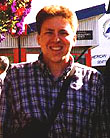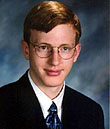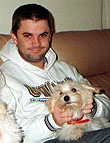|
|
This topic comprises 3 pages: 1 2 3
|
|
Author
|
Topic: Tri-Circle Autoscope Drive-In Theater
|
|
|
|
|
|
|
|
|
|
|
|
|
|
|
Brad Miller
Administrator

Posts: 17775
From: Plano, TX (36.2 miles NW of Rockwall)
Registered: May 99
|
 posted 02-05-2002 08:40 AM
posted 02-05-2002 08:40 AM




I finally was able to get into Geocities page and have placed the pictures on the Film-Tech server for archival use. They can be viewed here .What crazy loon came up with that!!! And some of you said I was crazy with my interlocking. Compared to this, I don't think so. What size xenon was in that lamphouse? Has anyone here ever been to one of these theaters? Does anyone know if one of the techs who has ever set one of those things up is still around? Perhaps even just someone who has had to go in and re-align those mirrors? This certainly beats out AMC's record of 30 screens! Anyone else notice the odd similarity between Fritz the Cat and Front Row Joe?  I am moving this topic to the Film Handler's Forum.
| IP: Logged
|
|
|
|
Jerry Chase
Phenomenal Film Handler
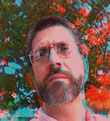
Posts: 1068
From: Margate, FL, USA
Registered: Nov 2000
|
 posted 02-05-2002 10:32 AM
posted 02-05-2002 10:32 AM




LOL! I sometimes wondered how those circular drive-ins worked.If I were at one, I'd have a great temptation to lob a rock at the mushroom canopy. A good thwack would have probably jiggled all the pictures. I'm a little surprised that there was only one row of screens. I would have thought two rows would be possible at least. The wasted space around the center makes this a design that couldn't work in areas with a higher land value.
I wonder what the light output to each screen was. Looks like there might have been 100 3' x 5' screens = 1500 sf. That equals a 25' x 60' regular screen, but over 1/2 the light output is lost in the grid that holds the little lenses. I'd guess maybe 1/3 of the light output made it to the screens.
Rear screen projection involves losses as well, depending upon the screen material. I'd guess 1/2 the light would be lost to back scatter unless those screens were fresnel lenses. I can't imagine the pictures being anything but dim.
| IP: Logged
|
|
|
|
Dave Bird
Jedi Master Film Handler
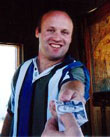
Posts: 777
From: Perth, Ontario, Canada
Registered: Jun 2000
|
 posted 02-05-2002 11:29 AM
posted 02-05-2002 11:29 AM





Gordon- So THAT'S what the huge warehouse-type building (that the conventional screens are now attached to) was for at the "5" in Oakville! Wonder why they did it? I suspect the inner-workings have given way to storage, it would be fun to go in and look at. Gee, you could close the outdoor in the winter, put up an opaque covering
over the rear-projection screen and run an indoor all winter! But to my main post, all you ever wanted to know about the Autoscope:There are a number of great books on Drive-In's, the best technical resource is Kerry Segrave's: "Drive-In Theaters: A History From Their Inception in 1933". Chapter 10 is titled "Strange Drive-Ins", the below excerpted starting in paragraph 3. >>>
Almost always the trend in drive-ins was to bigger and bigger, but not quite always. Tom Smith was a theater owner in Urbana, Missouri, during the early 1950s. An advocate of the even then not new technique of rear-projection, Smith spent two years tinkering until 1953, when he displayed his Multiscope Drive-In working model. This system had small screens placed around the perimeter of a circle with one car in front of each screen. In the
center of the circle sat the projection booth, which back-projected the film onto each screen. How one projector put the identical image on any number of screens was a secret that Smith would not reveal. According to the inventor a full circle would be 600 feet in diameter, which would allow space for one hundred fifty to two hundred cars. Tom's working model used 270 feet of the circle, accommodating forty-two cars. Each 30-by-40-inch plastic screen, with
a wide black masking border, was recessed slighty into a wooden frame. With those measurements the diagonal of the screen was around fifty inches, smaller than many of today's big-screen home television sets. Smith was unsure of the cost of his invention to a prospective purchaser as he had built the entire model by hand out of wood. However, he felt the savings with his Multiscope system would be great, as ramping costs and screen-tower costs were eliminated. As well, the projector used much less power to produce a picture Smith claimed was better than that found at a standard-size ozoner. The relatively small number of cars it held would be just right for
small towns and remote rural areas, thought the investor. "You could say it's rather crude, but there is no denying that the result is comparable with the best of front-projection, indoors and out," said Tom. "I don't think we'll make a million dollars out of this brain-child, but I do think we've got something here." This rather bizarre attmept to miniaturize the drive-in didn't end there, although Tom Smith's name would not resurface. [ed note: Although, it does in the Sanders book, with "co-inventor"
Bert Crowley in Albequerque NM in '63.] Ten years after Smith unveiled his model the Autoscope Drive-In appeared in Albequerque, New Mexico. In this incarnation 260 screens for individual cars
were provided in a series of rows. [ed note: The picture which won't scan very well but is on page 101 of the Segrave book, shows this theater's layout to be similar to a regular drive-in, tiered parking
in a "fan" layout, projector must be at the front where the screen tower usually is.] One central projector conveyed the image to all screens at once by means of a series of mirrors. Each screen
was 3 by 5 feet, a diagonal of about seventy inches. Albequerque reportedly had two of these Autoscopes operating in 1963. The idea didn't catch on, and they quickly died out. Ten years after the Autoscope, we were back to a very Smith-like ozoner, in Richland Washington. The Smith patent, if he had one, would by then have expired, putting the technology behind it
into the public domain. Lloyd Honey of that city already owned a couple of standard-size drive-ins in the area when he opened a miniature one on May 30, 1973. It was circular in shape, with 120 individual screens each of which was 3 by 4 feet, a sixty-inch diagonal. The projection booth was located in the center of the circle, 165 feet from the viewing area. Using 120 lenses and
reflecting mirrors, the image was back-projected to all the screens. Sound was picked up on the car radios. Honey said that this theater - built at a cost of $70,000 - needed just two people to operate it. While not designed specifically for X-rated films, this new theater "could very well show them," Honey conceded. He claimed that it was the "first of its kind on the West Coast." It was also the last. >>> Back to me: An ad on page 101 says:
-PICTURE CANNOT BE SEEN FROM SURROUNDING AREAS.
-Now is the time to own the patent rights in your state.
-There's no doubt about it, visible "X" is out (now banned in Rhode Island).
-Circle theatres may be designed to fit in only a corner of your present DR-IN.
-Seven basic layouts, sometimes existing theaters can be converted.
-Patented layouts, single circles, flip-flop, half circles, double circles, you name it - we have it
or we're working on it.
-SEVEN theatres now in operation- FOUR in buiding- EIGHT in zoning- FIVE patents issued-THREE pending and more on the DRAWING BOARD.
-18 states and 3 Foreign Countries New Licensed.
Companies name was United States TRAD (Theatre Research and Development) I recall that we discussed these in the "Drive-In Discussion" and it was felt that a couple of these were still open into the 80's, one perhaps into the 90's (Missouri???).
| IP: Logged
|
|
|
|
|
|
|
|
|
|
All times are Central (GMT -6:00)
|
This topic comprises 3 pages: 1 2 3
|
Powered by Infopop Corporation
UBB.classicTM
6.3.1.2
The Film-Tech Forums are designed for various members related to the cinema industry to express their opinions, viewpoints and testimonials on various products, services and events based upon speculation, personal knowledge and factual information through use, therefore all views represented here allow no liability upon the publishers of this web site and the owners of said views assume no liability for any ill will resulting from these postings. The posts made here are for educational as well as entertainment purposes and as such anyone viewing this portion of the website must accept these views as statements of the author of that opinion
and agrees to release the authors from any and all liability.
|

 Home
Home
 Products
Products
 Store
Store
 Forum
Forum
 Warehouse
Warehouse
 Contact Us
Contact Us




 Printer-friendly view of this topic
Printer-friendly view of this topic
